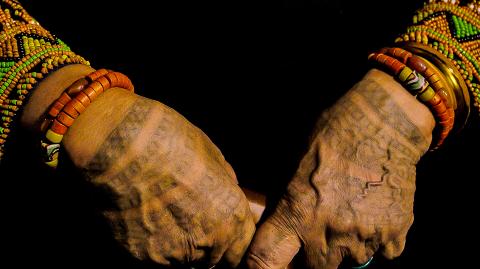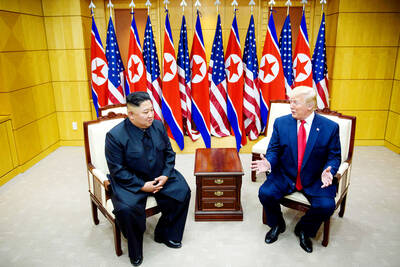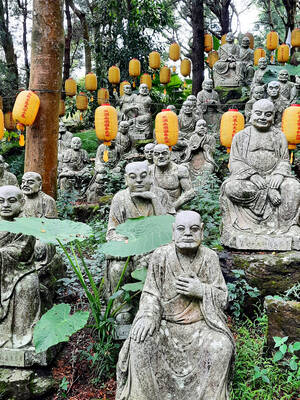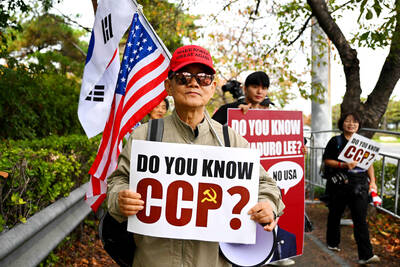Young Paiwan Aborigines from Pingtung County will take center stage at the National Concert Hall in Taipei tonight and tomorrow to perform Story of the Daughter of the Sun (太陽的女兒), the second musical program in the this year’s Taiwan International Festival of Arts.
The performers are students from the Taiwu Elementary School in Pingtung County’s Taiwu Township (泰武) who belong to the Taiwu Children’s Ancient Ballads Troupe (泰武古謠傳唱), as well as elders of the Puljetji community.
The troupe, which was founded in 2004 by Camake Valaule, a teacher at the school, specializes in traditional Paiwan songs. It has toured internationally and won a few Golden Melody Awards for its albums.

Photo courtesy of Tang Chien-che
Paiwan mythology says that the Paiwan are descendants of the sun. Traditionally, the Puljetji community’s leadership has been passed down to the eldest child of the leader, be it a boy or a girl, who is then known as the “son of the sun” or “daughter of the sun.”
Camake teamed up with theater director Wei Ying-chuan (魏瑛娟), the founder of the Shakespeare’s Wild Sisters (莎的劇團) troupe; film director Chen Hung-i (陳宏一) and installation artist Wang Te-yu (王德瑜) to create a multi-media production that tells the life story of the “Daughter of the Sun” through a mix of songs, traditional rituals and modern imagery.
The show runs 85 minutes without intermission, and the Concert Hall has warned that latecomers will not be admitted. There will be Chinese subtitles for the songs.
■ Tonight and tomorrow at the National Concert Hall (國家音樂廳), 21-1 Zhongshan S Rd, Taipei City (台北市中山南路21-1號)
■ Tickets are NT$700 to NT$2,000; available through NTCH ticketing, online at www.artsticket.com.tw and convenience store ticketing kiosk. Tomorrow night’s show is sold out.

US President Donald Trump may have hoped for an impromptu talk with his old friend Kim Jong-un during a recent trip to Asia, but analysts say the increasingly emboldened North Korean despot had few good reasons to join the photo-op. Trump sent repeated overtures to Kim during his barnstorming tour of Asia, saying he was “100 percent” open to a meeting and even bucking decades of US policy by conceding that North Korea was “sort of a nuclear power.” But Pyongyang kept mum on the invitation, instead firing off missiles and sending its foreign minister to Russia and Belarus, with whom it

When Taiwan was battered by storms this summer, the only crumb of comfort I could take was knowing that some advice I’d drafted several weeks earlier had been correct. Regarding the Southern Cross-Island Highway (南橫公路), a spectacular high-elevation route connecting Taiwan’s southwest with the country’s southeast, I’d written: “The precarious existence of this road cannot be overstated; those hoping to drive or ride all the way across should have a backup plan.” As this article was going to press, the middle section of the highway, between Meishankou (梅山口) in Kaohsiung and Siangyang (向陽) in Taitung County, was still closed to outsiders

President William Lai (賴清德) has championed Taiwan as an “AI Island” — an artificial intelligence (AI) hub powering the global tech economy. But without major shifts in talent, funding and strategic direction, this vision risks becoming a static fortress: indispensable, yet immobile and vulnerable. It’s time to reframe Taiwan’s ambition. Time to move from a resource-rich AI island to an AI Armada. Why change metaphors? Because choosing the right metaphor shapes both understanding and strategy. The “AI Island” frames our national ambition as a static fortress that, while valuable, is still vulnerable and reactive. Shifting our metaphor to an “AI Armada”

The Chinese Communist Party (CCP) has a dystopian, radical and dangerous conception of itself. Few are aware of this very fundamental difference between how they view power and how the rest of the world does. Even those of us who have lived in China sometimes fall back into the trap of viewing it through the lens of the power relationships common throughout the rest of the world, instead of understanding the CCP as it conceives of itself. Broadly speaking, the concepts of the people, race, culture, civilization, nation, government and religion are separate, though often overlapping and intertwined. A government